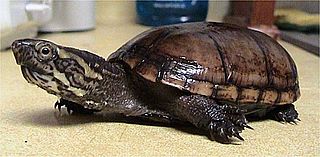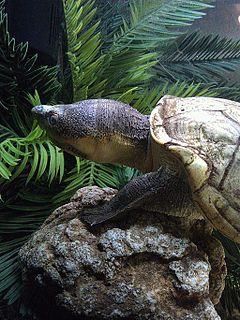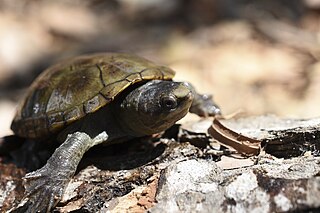
Nayarit, officially the Free and Sovereign State of Nayarit, is one of the 31 states that, along with Mexico City, comprise the Federal Entities of Mexico. It is divided in 20 municipalities and its capital city is Tepic.

The Kinosternidae are a family of mostly small turtles that includes the mud turtles and musk turtles. The family contains 25 species within four genera, but taxonomic reclassification is an ongoing process, so many sources vary on the exact numbers of species and subspecies. They inhabit slow-moving bodies of water, often with soft, muddy bottoms and abundant vegetation.

Kinosternon is a genus of small aquatic turtles from the Americas known commonly as mud turtles.

The yellow mud turtle, also commonly known as the yellow-necked mud turtle, is a species of mud turtle in the family Kinosternidae. The species is endemic to the Central United States and Mexico.

The Tabasco mud turtle, commonly known as pochitoque in Tabasco, Mexico, is a small turtle which belongs to the family Kinosternidae. It can be found in central Veracruz, Tabasco, northern Guatemala and Belize. This turtle lives in small streams, marshes and ponds. Its feeding habits are mainly carnivorous and it is a nocturnal animal. Although this turtle doesn't have a wide range it can be common at some sites. In Tabasco this turtle is an important part of its popular culture as well as being an ingredient in Tabasco's gastronomy in spite of its special protected status.

Creaser's mud turtle is a species of mud turtle in the family Kinosternidae. The species is endemic to the Yucatán Peninsula in southeastern Mexico.
Dunn's mud turtle, also known as the Colombian mud turtle, is a species of turtle in the family Kinosternidae. The turtle's habitat is fresh water, swamps and slow rivers.

The Oaxaca mud turtle is a species of mud turtle in the family Kinosternidae. It is endemic to Mexico. Both the common name and the scientific name derive from Oaxaca, a Mexican state. The International Union for Conservation of Nature has rated this species as "data deficient" as there is insufficient information available to judge its conservation status.

The Sonora mud turtle, also known as the Sonoyta mud turtle, is a species of turtle in the Kinosternidae family. It is found in Mexico and the United States. The Sonoran mud turtle species is heavily influenced by its environment. Depending on the amount of water available due to fixed water sources or rainfall, is how tolerant the mud turtle is to drought. The species drought tolerance is extremely variable depending on its environment.

The eastern mud turtle or common mud turtle is a common species of turtle in the family Kinosternidae. The species is endemic to the United States. There are two recognized subspecies.

The striped mud turtle is a species of turtle in the family Kinosternidae. The species is native to the southeastern United States.

The Arizona mud turtle is a species of mud turtle in the family Kinosternidae found in the deserts of Arizona and Sonora (Mexico). It is a semi-aquatic turtle. It lives in impermanent puddles, and avoids permanent rivers and lakes.

The Jalisco mud turtle is a species of mud turtle in the Kinosternidae family endemic to Mexico. It is found in Colima and Jalisco.

The Durango mud turtle is a species of mud turtle in the Kinosternidae family.

Herrera's mud turtle is a species of mud turtle in the family Kinosternidae. The species is endemic to Mexico.

The rough-footed mud turtle is a species of mud turtle in the family Kinosternidae. The species is endemic to the southwestern United States and northern Mexico.

The white-lipped mud turtle is a species of mud turtle in the family Kinosternidae. The species is endemic to Central America and northwestern South America.

The scorpion mud turtle is a species of mud turtle in the family Kinosternidae. It is found in Mexico, Central and South America. It is a medium to large kinosternid with a domed, oval upper shell 92–270 mm (3.6–10.6 in) long. Males regularly exceed 200 mm. The scorpion mud turtle is a highly aquatic, adaptable kinosternid that will live in almost any body of water. It is primarily omnicarnivorous, a glutton, and feeds on a wide variety of aquatic invertebrates and vertebrates, including carrion and bird eggshells. It also feeds on plant material such as algae, fruits, nuts, seeds and aquatic plants. In captivity, poorly fed K. scorpioides can be cannibalistic, biting off the toes and limbs of conspecifics. Females probably lay 1 to 6 hard-shelled eggs. Like many kinosternids, they probably construct a shallow terrestrial nest with little cover.

Mexican mud turtle, or Guanajuato mud turtle, is a species of mud turtle in the family Kinosternidae. Endemic to Mexico, it is found in Aguascalientes, Colima, Durango, Guanajuato, Guerrero, Hidalgo, Jalisco, Michoacán, México, Morelos, Nayarit, Oaxaca, Puebla, Queretaro, San Luis Potosí, Sinaloa, Sonora, Tamaulipas and Zacatecas, where they inhabit moist environments, such as shallow ponds, lakes, rivers or intermediate temp. tropical forest areas.

The Vallarta mud turtle is a recently identified species of mud turtle in the family Kinosternidae. While formerly considered conspecific with the Jalisco mud turtle, further studies indicated that it was a separate species. It can be identified by a combination of the number of plastron and carapace scutes, body size, and the distinctive yellow rostral shield in males.

















